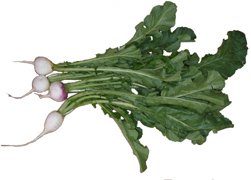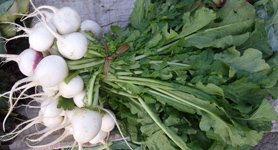Turnip greens Nutrition facts
Turnip greens are dark-green leafy tops of the plant turnip. The greens indeed hold more nutrition profile than the vegetable tuber itself concerning vitamins, minerals, and health-benefiting antioxidants.
Turnips are members of the Brassicaceae family and have the same standard growth characteristics as other brassica members such as cabbage, kale, brussel sprouts, etc.

|
| Turnips with green tops. |
Turnips roots can be grown during all the seasons in the temperate regions. However, its top greens can be at their best during winter. A warm climate would be detrimental since it affects the roots, which turn woody and brittle, and leaves become deep-green and bitter in taste. The plant requires well-drained fertile soil.
In order to reap turnip's tender greens, the crop is planted closely at 4 to 6 inches apart between the seedlings in order to stunt their bulb (tuber) growth and direct their nutrition instead of storing in top greens. Its young, tender leaves should be harvested early when the plant reaches about 4-6 inches tall.
Turnip greens feature light-green, broad leaves with long petioles, rising directly from atop its tuber. The greens feature a similar flavor as mustard greens but with a less intense spicy flavor. Young tender greens indeed feature a sweet flavor with a subtle taste of peppery notes.
Health benefits of Turnip greens
Turnip tops carry more vitamins and minerals than those of the vegetable tuber itself. Besides, the leafy tops are very low in calories; carrying just 32 calories per 100 g.
Like kale and mustard greens, turnip tops are quite compact regarding the nutrition profile of vitamins and minerals and health-benefiting antioxidant properties.
Turnip greens are one of the excellent sources of ß-carotene, lutein, and zeaxanthin. 100 g fresh raw greens provide 6952 µg, and 11984 µg of ß-carotene and lutein-zeaxanthin levels respectively. These flavonoids have potent antioxidant and anti-cancer activities. Beta-carotene is converted into vitamin A inside the human body.
Zeaxanthin, an important dietary carotenoid is selectively absorbed into the retinal macula lutea in the eyes where it is thought to provide antioxidant and protective light-filtering functions. Thus, it helps prevent retinal detachment and offers protection against "age-related macular degeneration related macular degeneration disease" (ARMD) in the elderly.
The top greens are one of the highest vitamin-A sources in the plant kingdom. 100 g leaves provide 11,587 IU or 386% of RDA.
Vitamin A is required for maintaining healthy mucosa and skin and is essential for vision. Foods rich in this vitamin are known to offer protection against lung and oral cavity cancers.
Again, they are among the top vegetable sources for vitamin-K; 100 g provides 251 µg of this vitamin which is about 209% of the recommended intake. Vitamin K has a potential role in bone health by promoting osteoblastic (bone formation and strengthening) activity. Adequate vitamin K levels in the diet help limit neuronal damage in the brain; thus, has an established role in the treatment of patients who have Alzheimer's disease.
100 g of fresh leaves contain 60 mg, or 100% of daily recommended levels of vitamin C . Vitamin C is a modestly potent water-soluble antioxidant that helps the body develop resistance against infectious agents and scavenge harmful oxygen-free radicals.
This leafy vegetable is notably good in many B-complex groups of vitamins such as riboflavin, folate (48% of RDA/100g), niacin, vitamin B-6 (pyridoxine), thiamin, pantothenic acid, etc., that are essential to the body as part of coenzymes during the metabolism in the body.
Its leaves are also a rich source of minerals like magnesium, copper, calcium, sodium, potassium, iron, manganese, and phosphorus. Potassium is an important component of cells and body fluids that helps regulate heart rate and blood pressure by countering the effects of sodium. The human body uses manganese as a co-factor for the antioxidant enzyme, superoxide dismutase. Iron is required for cellular oxidation and red blood cell formation.
Turnip greens are one of the finest sources of essential vitamins, minerals, and antioxidants that can offer protection from vitamin-A deficiency, osteoporosis, iron-deficiency anemia, and believed to protect from cardiovascular diseases and possibly from colon cancers.
| Principle | Nutrient Value | Percent of RDA |
|---|---|---|
| Energy | 32 Kcal | 1.5% |
| Carbohydrates | 7.13 g | 5.5% |
| Protein | 1.50 g | 3% |
| Total Fat | 0.13 g | <1% |
| Cholesterol | 0 mg | 0% |
| Dietary Fiber | 3.2 g | 8% |
| Vitamins | ||
| Folates | 194 µg | 48% |
| Niacin | 0.600 mg | 4% |
| Pantothenic acid | 0.380 mg | 7.5% |
| Pyridoxine (B-6) | 0.263 mg | 20% |
| Riboflavin | 0.100 mg | 7.5% |
| Thiamin | 0.070 mg | 6% |
| Vitamin A | 11587 IU | 386% |
| Vitamin C | 60 mg | 100% |
| Vitamin K | 251 µg | 209% |
| Electrolytes | ||
| Sodium | 40 mg | 3% |
| Potassium | 296 mg | 6% |
| Minerals | ||
| Calcium | 190 mg | 19% |
| Copper | 0.350 mg | 39% |
| Iron | 1.10 mg | 14% |
| Magnesium | 31 mg | 8% |
| Manganese | 0.466 mg | 12% |
| Phosphorus | 42 mg | 6% |
| Selenium | 1.2 µg | 2% |
| Zinc | 0.19 mg | 1.5% |
| Phyto-nutrients | ||
| Carotene-ß | 6952 µg | -- |
| Crypto-xanthin-ß | 0 µg | -- |
| Lutein-zeaxanthin | 12825 µg | -- |
Selection and storage

|
| Turnip greens with tubers in a market. |
Turnip tops are at their best during fall and spring. Fresh greens are also readily available all around the year. In the market, choose freshly harvested heads either alone or bearing the vegetable tuber. Choose fresh-looking, young tender deep green leaves with a firm petiole. Generally, the top greens are tied in bunches and sold along with their small taproot. In that case, look for small, healthy, firm turnip tubers.
Avoid yellow, sunken, wilted, or over-matured leaves as they are less appetizing and spoil early. As with any other greens, turnip tops also perish quickly and should be consumed as soon as it is harvested.
Once at home, sever the top greens from the root, using a knife an inch above the root top. If left intact, the greens deprive moisture and nutrients of the tuber. Store them in the refrigerator set at high relative humidity of over 95% where they stay fresh for 2-3 days.
Preparation and serving methods
Turnips tops are at their best during winter and spring lasting from November until February. Wash the greens in cold water to rid of any surface dirt. Mop them dry using a paper towel. Chop closely using a paring knife for even cooking.
Turnip tops feature very broad leaves akin to beets or swiss chard with long and sometimes wide, thick petioles. Trim away any tough and woody petioles. Remove any old overmature, wilted, bruised leaves. Then, wash prepared leaves in a colander under cold tap water to remove any surface sand and dirt. Gently swish away excess water or mop dry using a paper towel. Chop the leaves and petioles to the desired length using a kitchen knife.
Young tender greens can be eaten raw or preferably mixed with other greens and vegetables. However, large mature leaves are quite bitter in taste as they compose loads of minerals and vitamins and are, therefore, preferred only after cooked, sautéed, steamed, or braised.
Here are some serving tips:
In the Southern states of US, many Southern-style dishes prepared using freshly harvested turnip tops especially mixed with complementing greens such as kale, collards, mustard greens along with bacon, and salt-cured pork in mouth-watering recipes.
In South Asia, turnip greens are generally mixed with milder greens like spinach in the preparation of saag recipes. The greens can be added to stuffing, casseroles, quiche, stews, stir-fry, etc.
Although not as popular as kale chips, greens of turnips can be employed as chips.
Turnip greens can be juiced into a healthy drink. However, raw greens impart a bitter taste and a tinge of soreness to the oral mucosa. This can be avoided by juicing gently steamed greens in place of raw ones.
Safety profile
Oxalic acid content in the turnip greens is very small (0.05 g/100g) in comparison to other high oxalate content greens and vegetables like turnip-tuber (0.21g/100g), amaranth (1.09 g/100g), parsley (1.70 g/100g), etc. This bitter principle in mature leaves is because of their high mineral content. It can be minimized by boiling turnip greens in hot water and then discarding them before adding the greens to recipes. (Medical disclaimer).
≺≺ Back to Vegetables from Turnip greens. Visit here for an impressive list of vegetables with complete illustrations of their nutrition facts and health benefits.
≺≺ Back to Home page.
Further reading:
University of Illinois Extension-Watch your garden grow.
Oxalic acid content of selected vegetables-USDA.